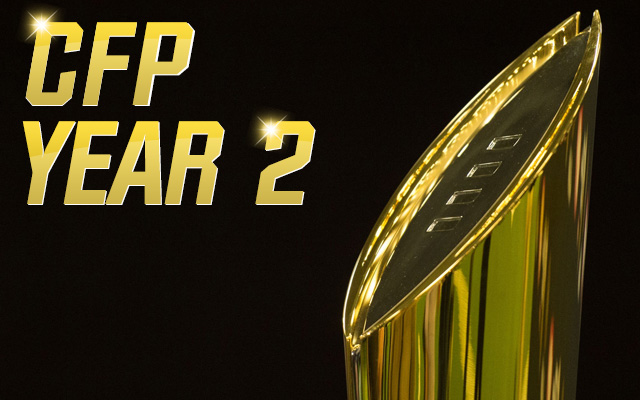Amidst the wild, unpredictable first year of the College Football Playoff, the sport has become … somewhat stable and predictable.
If anything, college football has settled into an easy rhythm having traded the hidden formulas of the BCS computers for the hidden agendas of the CFP Selection Committee.
Human logic over logic boards.
OK, I'm kidding, but just a little. TCU is still waiting for a proper explanation for being left out.
Going into year two of the CFP, though, we can make these general assumptions.
It’s easier to pick the playoff teams, than it is to pick the playoff winner: The selection committee has laid out a template, even if it is made of parchment paper. For now, let’s assume the committee favors conference champions because, well, they do in the small sample size we have available.
Start with a list of one man’s realistic Power Five 2015 conference contenders.
SEC: Alabama, Auburn, Georgia
Pac-12: Stanford, USC, Oregon, Arizona State
Big 12: TCU, Baylor
Big Ten: Michigan State, Ohio State
ACC: Florida State, Clemson
That’s only 13 teams. We can quibble, but your money would do well if the list was limited to picking four from among that group. Those programs have accounted for seven national championships since 2004. Picking four out of 13 means you only need a 31 percent success rate. The unpredictability begins in early December. As No. 4 seed Ohio State showed us, it’s harder to pick the playoff winner than it is the playoff participants.
Based on history alone, there are only a handful of teams that can win it in any given year. In the BCS era (1998-2013), only 15 teams even played for a championship. Four of those were involved in the first playoff. Include the top four from each year in the BCS era and that overall list grows only to 25 possible contenders.
(Power) Five doesn’t fit into a (Football) Four: The game’s stewards knew that when they launched a postseason that ended up being a multi-million dollar game of musical chairs. There are five power conferences. At most, four of them are going to make it. This doesn’t account for Notre Dame or two teams from the same conference getting in. That particular meltdown still awaits.
For now, we’ll stick to the basics. If -- before last season -- you determined the Big 12 was going to be left out, it was easier to pick Florida State, Alabama, Oregon and Ohio State as the four conference champs who were going to be in. That, in fact, happened in this space.
Further evidence of the predictability of the system.
The fallout won’t stop: The first big unintended consequence of the CFP was the plight of that musical chairs loser. Everything the Big 12 did, or didn’t do, in the offseason seemed to relate to it being left out. Expansion? Championship game? The 'One True Champion' slogan got beaten up worse than one of Ronda Rousey’s sparring partners.
Here we are a couple of weeks from the start of the 2015 season and the Big 12’s 2014 remains a hot topic.
What fallout will await the Left Out from this season?
The season has been divided into three distinct parts: Part 1: The traditional human polls -- diminished with the advent of the playoff -- are now meaningless after the CFP rankings kick in. This year that’s not until Nov. 3.
Part 2: The Tuesday night release of those rankings ratchets up the scrutiny on the regular-season jockeying. That hit home last year when, going into the last week of the season, undefeated Florida State dropped to No. 4. I actually asked CFP chair Jeff Long if the Seminoles were in danger of potentially being left out of the playoff. He did not laugh.
Part 3: The playoff is a separate entity. For Alabama, being the prohibitive No. 1 on Pick ‘Em Day didn’t mean squat. It’s how you do in the bracket that counts.
Conclusion: Being No. 1 at any point before December, these days, matters less than the process involved in winning the tournament.
The New Parity: In early December, who would have thought the Buckeyes would endure? There was the emergence of a "Cinderella" -- a rare concept in major-college football -- that added to the appeal and acceptance of the playoff.
Because of the randomness of a tournament, no conference is likely to ever win seven consecutive titles again. Sorry, SEC. Actually, it’s going to be hard for any conference to win two in a row. There will be injuries, attrition, fatigue and the odd third-string quarterback in December and January.
Assume a new age of parity -- at least for the power conferences -- because …
The playoff has solidified a caste system that further rewards the elite: The playoff is an upgrade over the BCS in that a four-team playoff will account for every undefeated major conference team. The last time there were as many as three power conference unbeatens was 2004.
It’s hard to imagine in this age an unbeaten SEC champion being left out. That actually happened to Auburn 12 years ago.
The unknown: What does Boise State -- or another Group of Five team -- have to do to get in the top four? Consider this scenario: The committee evaluating a 13-0 Boise vs. an 11-2 SEC champion for the last playoff spot.
The known: Unless things change drastically, the SEC champion is guaranteed to get a spot in any given year.
Talk of an eight-team bracket won’t go away: In one sense, it would be easy to expand the field. In another, it’s next to impossible. Adding another layer of playoffs might mean the elimination of conference championship games. That would require the CFP to buy the SEC out of its game, for starters, ending a traditional and lucrative postseason Southern football holiday in Atlanta.
Plus, player welfare will continue to be a huge issue. If those conference title games stay, we’re talking about a 16-game season for two teams. In an eight-team bracket, four semifinal teams would be playing 15 games.
If something does happen, look for it to occur after the 2019 season. There is a window after that season for the CFP for evaluate the “host” bowls (Fiesta, Cotton, Peach).





















